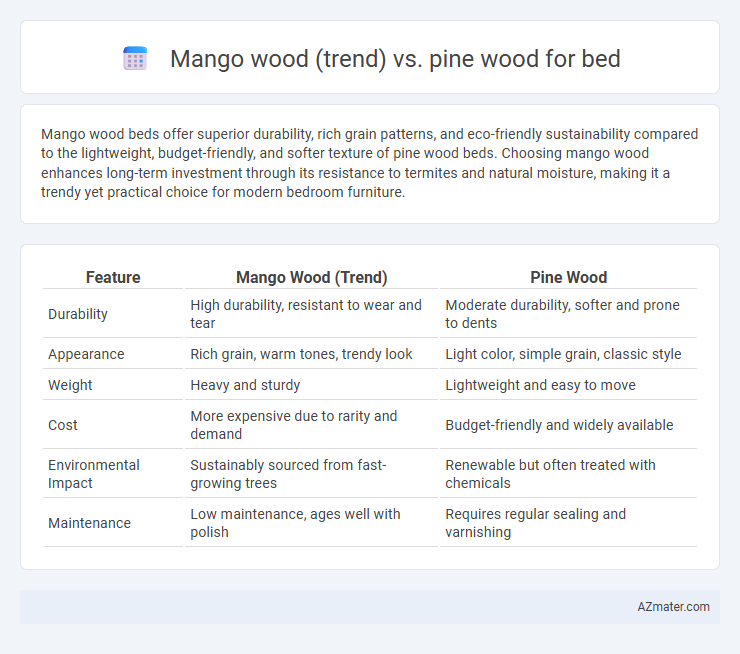Mango wood beds offer superior durability, rich grain patterns, and eco-friendly sustainability compared to the lightweight, budget-friendly, and softer texture of pine wood beds. Choosing mango wood enhances long-term investment through its resistance to termites and natural moisture, making it a trendy yet practical choice for modern bedroom furniture.
Table of Comparison
| Feature | Mango Wood (Trend) | Pine Wood |
|---|---|---|
| Durability | High durability, resistant to wear and tear | Moderate durability, softer and prone to dents |
| Appearance | Rich grain, warm tones, trendy look | Light color, simple grain, classic style |
| Weight | Heavy and sturdy | Lightweight and easy to move |
| Cost | More expensive due to rarity and demand | Budget-friendly and widely available |
| Environmental Impact | Sustainably sourced from fast-growing trees | Renewable but often treated with chemicals |
| Maintenance | Low maintenance, ages well with polish | Requires regular sealing and varnishing |
Introduction: Mango Wood vs Pine Wood in Bed Trends
Mango wood has surged in popularity for bed frames due to its durability, rich grain patterns, and sustainable sourcing, making it a trendy choice for eco-conscious consumers. Pine wood remains a classic option, appreciated for its affordability, lighter color, and ease of customization, fitting well with rustic and Scandinavian bedroom aesthetics. Comparing trends, mango wood beds dominate in luxury and artisanal markets while pine wood continues to appeal to budget-friendly and casual style segments.
Overview of Mango Wood and Its Rising Popularity
Mango wood, known for its dense grain and rich, warm tones, is gaining popularity in furniture making due to its sustainability and durability compared to pine wood. Its eco-friendly nature, sourced from mango fruit-producing trees that no longer yield fruit, appeals to environmentally conscious consumers looking for unique, sturdy beds. The trend reflects a shift towards hardwoods offering greater longevity and distinctive aesthetics over the traditional softness and affordability of pine wood.
Pine Wood: Classic Choice for Bed Frames
Pine wood remains a classic choice for bed frames due to its affordability, lightweight nature, and ease of customization through staining or painting. Unlike mango wood, which is prized for its rich grain patterns and durability, pine offers a softer texture that provides a cozy, rustic aesthetic favored in traditional and country-style bedrooms. Its natural knots and subtle hues create a warm and inviting atmosphere while maintaining structural stability and longevity in bed frames.
Durability Comparison: Mango Wood vs Pine Wood
Mango wood offers higher durability than pine wood, making it a preferred choice for beds due to its dense grain and resistance to wear and insect damage. Pine wood, being softer and lighter, is more prone to dents and scratches, reducing its lifespan in high-use furniture like beds. The long-lasting durability of mango wood ensures better structural integrity and aesthetic appeal over time compared to the relatively less resilient pine wood.
Aesthetic Appeal: Grain, Color, and Style Differences
Mango wood features a rich, warm hue with varied grain patterns that enhance its natural, rustic charm, making each bed unique and visually striking. Pine wood offers a lighter color with straighter, more uniform grain lines, lending a clean, minimalist look ideal for modern or Scandinavian-style bedrooms. The contrasting aesthetics of mango's bold, textured appearance versus pine's subtle simplicity allow diverse design expressions suited to different interior themes.
Sustainability and Eco-Friendliness
Mango wood is highly sustainable due to its fast growth and use of timber from already harvested trees, minimizing deforestation impact compared to pine wood, which often comes from slower-growing forests. Mango wood's durability and natural resistance to pests reduce the need for chemical treatments, enhancing its eco-friendliness compared to pine that may require more frequent maintenance and preservation chemicals. Choosing mango wood for beds supports sustainable forestry practices and lowers environmental footprints through efficient resource utilization and biodegradability.
Price and Affordability Factors
Mango wood beds offer a mid-range price point, combining durability and a rich, natural grain that enhances aesthetic appeal while remaining more affordable than expensive hardwoods. Pine wood beds are typically the most budget-friendly option, characterized by lighter weight and softer texture, but may lack the longevity and resistance to wear compared to mango wood. Price differences often reflect mango wood's higher density and sustainability factors, making it a preferred choice for those seeking a balance between cost, quality, and environmental impact.
Maintenance and Longevity
Mango wood beds offer superior durability and low maintenance due to their dense grain and natural oils that resist warping and pests, making them ideal for long-term use. Pine wood beds require more frequent care, such as sealing and polishing, to prevent dents and moisture damage because of their softer nature. Choosing mango wood ensures a longer lifespan with minimal upkeep, while pine demands more regular maintenance to maintain its aesthetic and structural integrity.
Choosing the Right Wood: Key Considerations for Buyers
Mango wood offers superior durability and a rich, unique grain pattern compared to the softer, more affordable pine wood commonly used in bed frames. Buyers considering longevity and natural resistance to pests often prefer mango wood for its sustainability and robustness. Pine wood, while cost-effective and lightweight, may require more maintenance and is prone to dents, making it ideal for budget-conscious buyers prioritizing easy handling over long-term endurance.
Conclusion: Which Is Better for Your Bedroom?
Mango wood offers superior durability, rich grain patterns, and resistance to pests, making it ideal for long-lasting, aesthetically pleasing bedroom beds. Pine wood, while more affordable and lightweight, is softer and prone to dents and scratches, requiring more maintenance over time. Choosing mango wood ensures a premium, sturdy bed with enhanced longevity and visual appeal for your bedroom.

Infographic: Mango wood (trend) vs Pine wood for Bed
 azmater.com
azmater.com